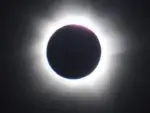It’s a rare phenomenon, the solar eclipse. Well, actually, it isn’t all that rare! In fact, in any given year, at least two and as many as five solar eclipses can be experienced. Of course, whether or not you can see the eclipse depends on where you are located on earth, and while you might expect the records of solar eclipses to correspond to the incorporation of scientific knowledge that helped people to understand what they were looking at, you might be surprised at how far back records of solar eclipses extend.
The Omen of the Eclipse
On June 4, back in 780 BC, China recorded the first historic solar eclipse, and there are many records of solar eclipses that extend back even further—largely because the solar eclipse became somewhat of a bad omen. The ancient Chinese were able to predict when solar eclipses would occur as early as 2500 BCE; however, the matter was of immense importance to them. They believed failing to predict an eclipse would put their emperor in danger, and legend has it that two ancient Chinese astrologers, Hsi and Ho, were executed when they failed to predict an eclipse that historians and astronomers believe occurred on October 22, 2134 BCE—potentially the oldest solar eclipse ever to be documented in human history.
The Chinese weren’t the only ones who were anxious for their leaders during solar eclipses, though. The Babylonians went a step beyond predicting solar eclipses and actually employed substitute kings to reign during the eclipse so their true kings would be protected from the anger of the gods. The anxiety had a long reign. Well after the time of Hsi and Ho, on August 2, 1133, the King Henry’s Eclipse prompted the further spread of the myth that eclipses are bad omens for rulers when King Henry I died shortly after an eclipse that would later be named for him.
The bad omen of the eclipse, however, has its roots back even further than those documented historical events. Because the eclipse was scientifically misunderstood, a number of legends spread around the world in an attempt to explain the sudden (and frightening) disappearance of the sun. Many cultures created legends of mythical figures eating the sun: a giant frog in Vietnam, wolves in Norse cultures, a celestial dragon in China (the Chinese word for eclipse, chih or shih, means to eat), and indigenous groups like the Pomo believed it was a bear. The ancient Greeks believed an eclipse was a sign that the gods were angry, an eclipse thus marking the beginning of disasters and destruction; and in Inuit folklore, an eclipse happened when the sun goddess, Malina, walked away from the moon god, Anningan, in anger, but the moon god managed to catch up with his sister.
Not just an omen
Of course, the history of solar eclipses doesn’t just come down to superstition and mythology. Solar eclipses have had some significant scientific impact: for instance, on May 29, 1919, a total solar eclipse helped British astronomer and mathematician Sir Arthur Eddington to prove Einstein’s theory of relativity; one that occurred on August 16, 1868 helped French astronomer Jules Janssen discover helium (thus named after the Greek word for the sun). Of course, if you have your heart set on superstition, then the next partial eclipse will take place on Friday the 13th in July—you’ll just have to be in Australia or Antarctica to see it.
Looking for a way to celebrate the longstanding scientific and mythological relationship between the earth and sun? Why not look into solar energy opportunities near you so you can see firsthand the power the sun can wield?












